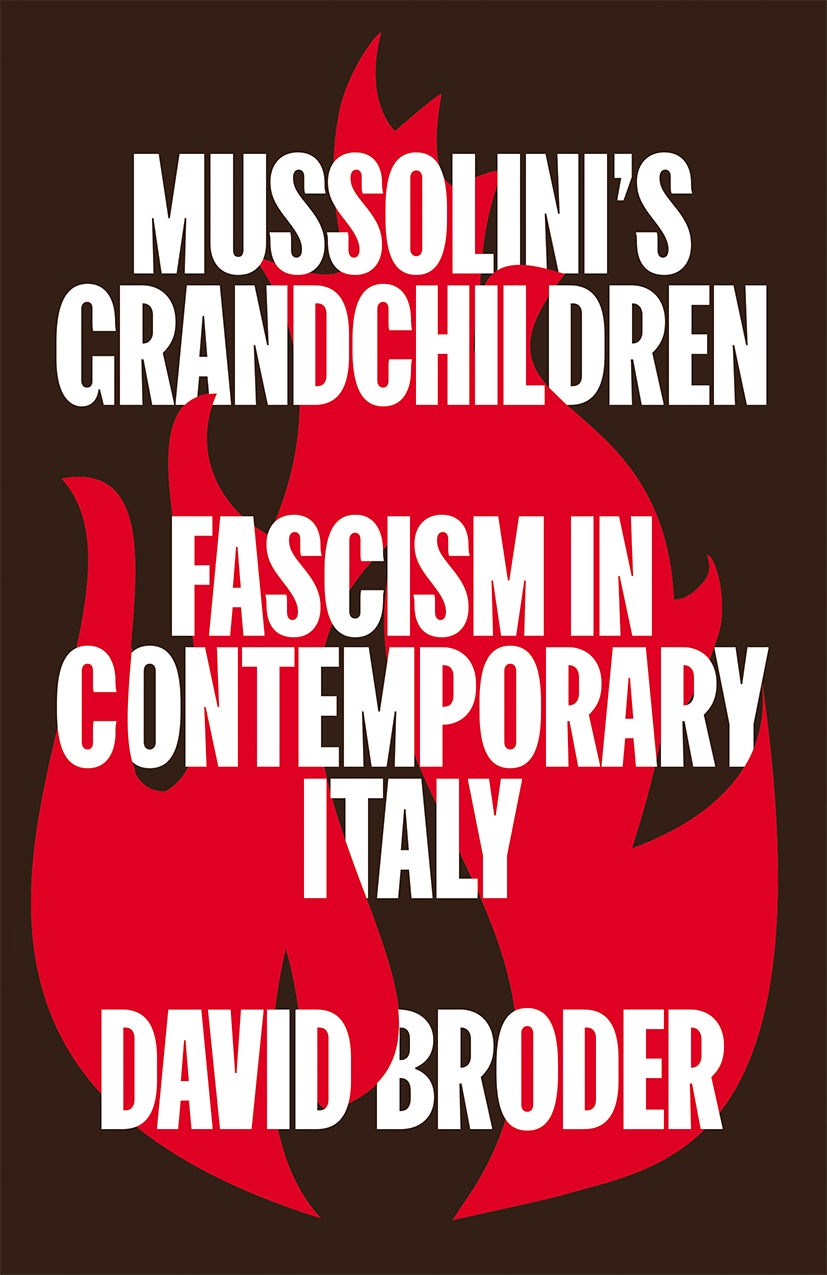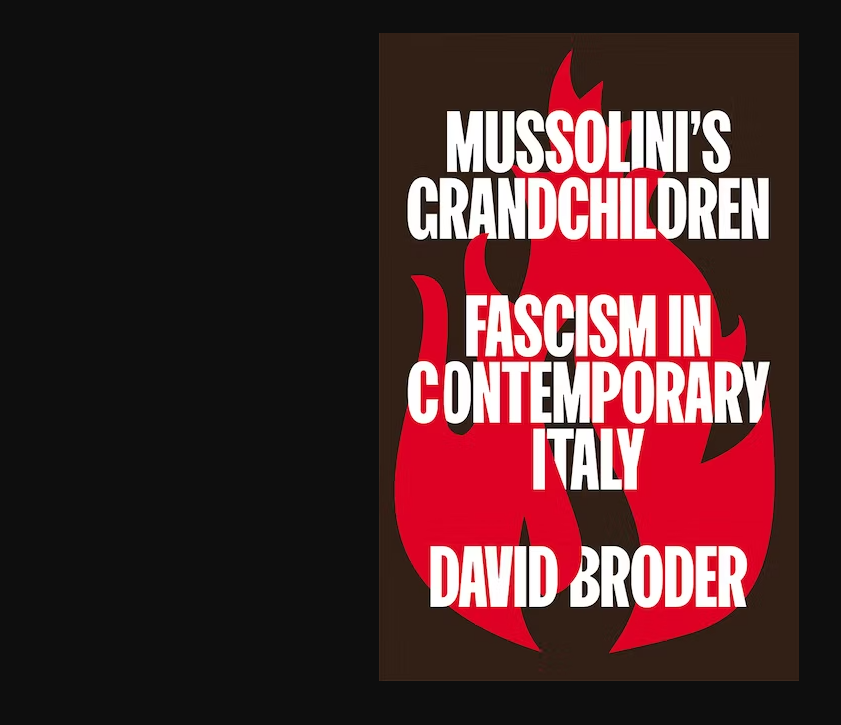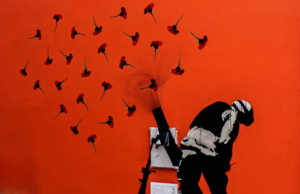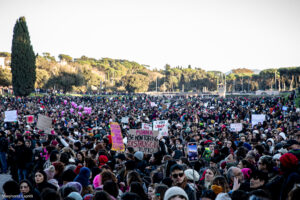“Mussolini’s Grandchildren by David Broder, recently published by Pluto Press in London, looks at Italy’s self-proclaimed “post-fascist” movements, which have their roots in historical fascism but claim to have “overcome” it. Read a full review by Franco Ferrari.
The rapid growth of the Brothers of Italy (Fratelli d’Italia) from a minor component of the right-wing coalition to the leading Italian party has meant that it has received little attention, both in the academic world and in the more general world of journalism. Initially, it was thought that it could be framed as a simple variant within the analysis of the radical or populist right. However, the arrival of its leader, Giorgia Meloni, in the government after the September 2022 elections, has forced us to pay more attention to the specifics of this party, which is on the one hand relatively recent, having arisen at the end of 2012, but on the other hand claims a continuity of almost seventy years.
Obviously, international public opinion, which is more attentive to Italian political events, immediately asked itself an inevitable question in the face of a party that openly declares itself the continuation and heir of the Movimento Sociale Italiano (Italian Social Movement). The MSI was a political force created by the will of those who had participated in the fascist experience and who, after the war, wished to keep the legacy alive, even in a context determined by their defeat and by the entry into force of a Constitution explicitly intended to be anti-fascist. A constitutional charter which, in addition to including among its transitional provisions the ban on the reconstitution of the Fascist Party, made explicit many values which were the expression of a vision of the world antagonistic to that of Mussolini’s regime.
David Broder’s book, Mussolini’s Grandchildren. Fascism in Contemporary Italy, recently published by Pluto Press, provides the non-Italian reader with some important keys to understanding the success of the Fratelli d’Italia, but it is also an important contribution for the Italian who wants to try to understand the characteristics of this party and the reasons for its success.
Broder, as well as being the European editor of Jacobin, the US socialist magazine which also produces a brilliant and intelligent website, is a young historian with an excellent knowledge of Italian reality. A few years ago he published a book on the success of populist parties in Italy, focusing in this case on the Lega and 5 Stelle, but he had previously written a thesis (later published) on the communist presence in Rome during the last years of the Second World War. He had dedicated particular attention to the dissident movement known as “Bandiera Rossa” (actually the Italian Communist Movement), which was particularly rooted in the Roman suburbs and which, it is right to remember in these days of polemic on the words of the President of the Italian Senate, Ignazio La Russa, had fallen in the Nazi-Fascist massacre of Fosse Ardeatine.
In dealing with Giorgia Meloni’s party, whether with the gaze of the historian, as in the case of Broder, or that of the political sociologist or political scientist, as in the case of other authors, it is necessary to answer two initial questions. The first concerns the relationship between the FdI and historical fascism. The title of the book seems to suggest, on the part of the author, a substantial identification between the two phenomena (“Mussolini’s grandchildren” and “fascism in contemporary Italy”). In reality, the reading given is decidedly more articulated and, in my opinion, entirely correct.
Giorgia Meloni’s party exhibits “unmistakable fascist influences: a legacy apparent in its victim narrative of World War II history, its celebration of post-war neo-fascist leaders, and its recasting of regime-era ideologues as generic Italian patriots”.
The “Brothers of Italy”, in contrast to the last period of Gianfranco Fini’s leadership in Alleanza Nazionale (the previous post-fascist party), does not consider it necessary to abandon this claim of historical continuity (which evidently arbitrarily separates the neo-fascism and fascism of the last twenty years). But it also considers that this is not an obstacle to its electoral success and to the acquisition of a broad consensus and legitimacy to govern.
Even in the controversies of these days, regarding the declarations of Ignazio La Russa on the partisan operation of Via Rasella against the Nazi-fascist troops present in Rome, if there is a nuisance in the Prime Minister (of which the conservative “Corriere della Sera” is the dutiful spokesman and prompter) this does not consist so much in the denigration of the Resistance and of anti-fascism, which he has shown on many occasions to share, as in inappropriately fueling controversies that divert attention from the policies on which the Government wants to focus attention.
On the other hand, Meloni herself, albeit in a less vulgar way than the President of the Senate, had taken steps, recalling the Fosse Ardeatine massacre a few days earlier, to provide a “racialising” reading, i.e. a massacre of Italians as Italians. On the other hand, Meloni herself, albeit in a less vulgar way than the President of the Senate, had taken steps, recalling the Fosse Ardeatine massacre a few days earlier, to provide a “racist” reading, i.e. a massacre of Italians as Italians. So we have two different but complementary forms of historical revisionism. The first is that of the criminalisation of the Resistance, the second is that of the reconstruction of history on the basis of a permanent ethnic opposition, which is the fundamental core of the vision of the world proposed by the fascist, neo-fascist and post-fascist right.
Broder reconstructs this process of historical revisionism, which became hegemonic in certain respects between the end of the 1980s and the 1990s, with attention and perspicacity. He recalls the various ways in which “mainstream” authors such as Giampaolo Pansa, a late popular journalist who wrote a series of books on the Second World War in Italy from the perspective of the fascist “victims”, and Bruno Vespa, a talk show host on the main public television channel, contributed to the downgrading of the anti-fascist narrative. And the role played by the redefinition of the history of the Foibe as an event inspired by an alleged anti-Italian ethnic cleansing. He also recalls how the then President of the Republic, Giorgio Napolitano (centre-left), contributed to this revisionist and (to a large extent) political falsification of history by supporting, in his 2007 speech, the ethnically charged re-reading (Slavs against Italians) of the affair of the Italian-Yugoslav border. This is not the only case, as Broder rightly recalls the text adopted by the European Parliament, which equates Nazism and Communism (without mentioning Fascism).
However, Broder rightly underlines that the continuity with the fascist link does not represent the entire ideological profile of the Brothers of Italy because, as he summarises, this party “has integrated the neo-fascist tradition into a broader nationalist identity politics”. And this allows it to “find a place within an international conservative movement that is increasingly concerned with the decline of civilisation”. A civilisation that legitimises the explicit or implicit defence of that “white supremacism” whose past and present Alessandro Scassellati has analysed in his recently published book.
This confluence in the international conservative movement is possible not only due to the strategy implemented (after some initial fluctuations) by the “Brothers of Italy”, in this case thanks to the Meloni-Fitto duo, the latter one of the few leaders of the party not of neo-fascist origin and current Minister of European Affairs, but also due to a relocation of the same international conservatism. This “national-conservative” environment is characterised by a “dramatisation of the political conflict: a defence of Western civilisation from its destruction by a conspiracy of elite and radical left forces”. In this context, there is also a redefinition of anti-communism, which remains a fundamental element of the far right’s ideology, but in new terms. “Its enemy – writes Broder – is not communism per se, but rather the spectre of communism projected onto various progressive causes, leftists and even liberals”.
This balancing act between neo-fascist continuity and inclusion in a broader “national-conservative” base is not without contradictions and continuous flaws. As evidenced by the repeated appearance of embarrassing statements or obscure biographies on the borderline between legal and illegal neo-fascism among the party’s exponents, those in the front row politically or those placed in the numerous positions offered by the spoils system.
Historical revisionism, redefinition in a nationalist sense (an “ethnic” not a “civic” nationalism) by the conservative right, are some of the elements that allow the “normalisation”, what in France is called the “dediabolization”, of the extreme right. To this we can add the new Cold War ideological framework that the Biden administration has given to international relations. Meloni himself was invited as a guest of honour to the “Forum for Democracy” recently held in Washington by the US presidency. On the other hand, there is a widespread view among analysts that Biden, speaking in Warsaw during his recent European tour, indicated that he sees the alliance with the ethno-nationalist right (which is also hostile to him at home) as an essential support for his global deployment.
Broder underlines another element that characterises the politics of the “Brothers of Italy”, namely the substantial disappearance of those elements of the “social right” that also had some influence in the MSI, at least in terms of demagogy, if not of political substance. There has often been talk of “welfare chauvinism” in relation to the new radical and populist right, of a defence of welfare, but only for the natives and in favour of the “nuclear” family. In reality, if we examine the party’s programmatic positions, the FdI is anything but a “welfarist” party. The key element of the economic policy of the post-fascist right is the revival of national capitalism as a response to the decline of civilisation.
Once the ideological and programmatic profile of the “Brothers of Italy” and its relations with the wider world of the nationalist and conservative right have been better defined, it is obviously necessary to ask ourselves about the reasons for the party’s success. Bearing in mind, as has been pointed out, that the votes that guaranteed its success came largely from voters already positioned on the right. First Berlusconi, who drove the neo-fascists out of the “ghetto”, then Salvini, who adopted many of the same themes but in a more populist framework, allowed Meloni’s party to benefit from the loss of credibility of the two leaders, presenting itself as a more “fresh” and “coherent” face. An attribute, coherence, that her many political twists and turns do not really allow to confirm.
At the root of the success of the post-fascist far right, Broder sees these tendencies: “a sense of permanent national decline and economic crisis; the collapse of the mass, class-based political parties that once mediated popular demands; and the rise of national-populist leaders who angrily denounce “globalist” conspiracies while integrating themselves into dominant international institutions.
All true elements, to which we can add the transition from the proportional to the majority electoral system, which has favoured the process of polarisation of the political system. Contrary to what its theorists imagined, for whom such a system would have led to a centripetal tendency of convergence in a moderate sense, in order to conquer the central voters (who, not coincidentally, are considered as belonging to the middle-upper class), this mechanism has favoured both anti-system populist actors and the radical right. Instead, it only had a negative effect on the radical left.
But the link between the success of what Steven Forti calls the “far right 2.0”, preferring this definition to the many others circulating among researchers engaged in understanding this phenomenon, and the particularities of Italian capitalism and its specific version of neoliberalism remains largely to be investigated. And with it, the reasons why voters of different orientations and social backgrounds recognise themselves in the “Brothers of Italy”.
The party leader seems to have a fairly clear vision of how to resolve some of the now historic problems of Italian capitalism (stagnation, low productivity in many sectors of the economy, etc.) with policies based on a rather archaic vision of capitalist development. However, it also has a clear idea of which social blocs might be capable of supporting such a policy: the middle classes, made up of small businesses, commerce, crafts, the liberal professions, sectors of a relatively stable and native “worker aristocracy”, the big bourgeoisie and big capital. In many respects, however, the development model and the social bloc seem rather archaic.
Meloni’s narrative is a combination of social conservatism, inattention to the ecological issue, autarkic impulses, social Darwinism. All elements that smell of the old stuff. For the Fratelli d’Italia, there is not only a past that does not disappear, but also an ancient past that wants to come to the surface again. As Broder concludes, Meloni has tried to explain that post-fascism does not want to be a “return to the past”. But here perhaps lies one of its many contradictions.
Mussolini’s Grandchildren. Fascism in Contemporary Italy 
by David Broder
2023 Pluto Press London
ISBN 978 0 7453 4802 5
Available here
References
Broder, David, (2020) First they took Rome. How the Populist Right Conquered Italy. Verso, London.
– (2021) The Rebirth of Italian Communism, 1943-44. Dissidents in German-Occupied Rome. Palgrave Macmillan, London.
– (2023), Mussolini’s Grandchildren. Fascism in Contemporary Italy. Pluto Press, London.
Donà, Alessia (2022), The rise of the Radical Right in Italy: the case of Fratelli d’Italia. Journal of Modern Italian Studies. 27:5, p. 775-794.
Ferrari, Franco (2021) FdI tra nuovo conservatorismo e vecchio neofascismo, Transform! Italia.
-(2021) Giorgia Meloni e la parola impronunciabile, Il Mulino.
-(2022) Italy’s poll leader says it’s “conservative – but its ideology has clear fascist elements, Jacobin.
Forti, Steven (2021), Extrema derecha 2.0. Que es y como combatirla. Siglo XXI, Madrid.
– (2022), “Prima gli italiani!” Cambios y continuidades en la ultraderecha italian: la Lega y Fratelli d’Italia. Revista CIDOB d’Afers Internacionals. 132, pp. 25-48.
Scassellati Sforzolini, Alessandro (2023) Suprematismo bianco. Alle radici di economia, cultura, ideologia della società occidentale. Derive Approdi, Roma.
Steven, Martin and Szczerbiak, Aleks (2022), Conservatism and “Euroealism in the European Parliament: the European conservatives and reformists under the leadership of Poland’s law and justice. European Politics and Society. pp. 1-18.
Vassallo, Salvatore e Vignati, Rinaldo (2023), Fratelli di Giorgia. Il partito della destra nazional-conservatrice. Il Mulino, Bologna.



